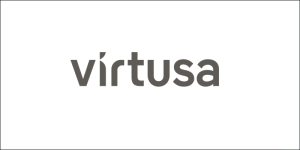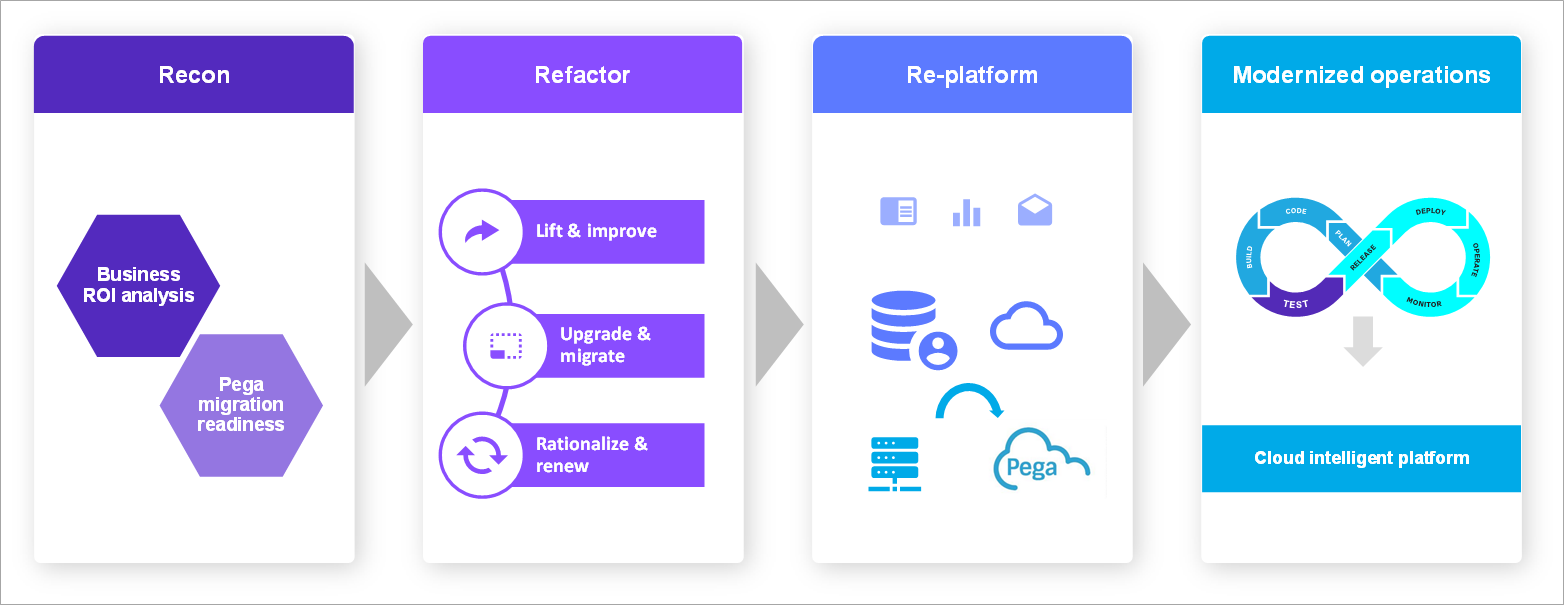AWS Partner Network (APN) Blog
Virtusa’s Triple-R Methodology for Migrating from On-Premises to Pega Cloud on AWS
By Dhammike Weerabaddana, Modernization CoE Lead – Virtusa
By Piyush Agarwal, AWS Ambassador – Virtusa
By Hussain Shabbir, Global Head of AWS CoE – Virtusa
By Néstor Gándara, Principal Partner Solutions Architect – AWS
 |
| Virtusa |
 |
Virtusa helps numerous clients migrate their Pega applications from on-premises to Pega Cloud running on Amazon Web Services (AWS).
Many of these clients are still using older Pega versions and, over the years, have accumulated technical debt which results in developer productivity challenges and limiting their ability to harness the latest Pega features.
Virtusa identifies opportunities using its proven Triple-R methodology (Recon, Refactor, Re-platform) to reduce the accumulated technical debt while seamlessly migrating to Pega Cloud.
With over two decades of experience on Pega, Virtusa surfaces what it would take to perform this upgrade and cloud migration, while managing and executing the project within a short timeline as generally requested by clients.
In this post, we will explore how Virtusa successfully navigates the challenges in migrating a Pega 7.1 application running on-premises to running on Pega Cloud with the latest platform release. We’ll also share how Virtusa manages to reduce the technical debt during the upgrade of the application and drive performance improvements.
Virtusa is an AWS Premier Tier Services Partner and Managed Service Provider (MSP) with AWS Consulting Competencies in Migration, DevOps, and Financial Services, among many others. An AWS Marketplace Seller as well, Virtusa is a full-scale IT service provider and cloud-led enterprise business transformation leader.
Solution Overview
As part of this solution, Virtusa generally utilizes the implementation knowledge of the application and further assesses the Pega 7.1 application in collaboration with the client’s infrastructure, development, and product owners. Rule implementation provided by Virtusa’s Recon Tool provides insight into areas that need to be remediated as part of the upgrade and cloud migration.
The upgrade involves replacing of the deprecated rules and constructs, as well as replacing custom controls and code, including user interface (UI) customizations, with Pega’s out-of-the-box controls and updated rules. The upgrade also involves retrofitting customizations within the overridden Pega Strategic Application and Platform Rules.
Data purging needs are also identified and implemented to optimize the database migration to Pega Cloud, and to improve application performance on an ongoing basis. Multiple dry-runs are set up to validate the cutover process, as well as optimize the same to reduce the application downtime during the production cutover.
Challenges
Due to its experience with Pega and migrating applications to Pega Cloud, Virtusa reviews the application to address some of the issues typically seen, such as:
- Large amount of technical debt in the outdated Pega 7.1 application that needed to be remediated.
- Delays in getting secure virtual private network (VPN) access to Pega Cloud instances that are established.
- Lack of environment with other downstream systems for integration testing.
- Fixed and aggressive timeline for delivery.
- Lack of a valid regression test suite, as well as test scenarios, with no traceability to requirements, to ensure acceptable test coverage.
- Greater-than-expected rule retrofit due to major changes within the Pega Strategic Applications used by the solution.
Pega 7.1 to Pega Cloud Migration and Modernization
To help clients migrate the Pega 7.1 application hosted on-premises to Pega Cloud, Virtusa analyzes the current-state application for modernization and its cloud readiness utilizing the Recon Tool. The team understands the current-state challenges and recommends migrating to Pega Cloud.
The scope of analysis includes the following focus areas:
- Current state of the application.
- On-premises application deployment architecture along with the Pega infrastructure setup.
- Pega platform and framework upgrade and retrofit impacts.
- Additional Pega Cloud-specific constraints.
- Data retention and archiving.
- Approach to the Pega Cloud migration.
Virtusa’s recommendations also identify opportunities to further decrease technical debt as part of the upgrade by replacing UI customizations with Pega Platform-provided UI capabilities. This improves the maintainability of the application, thereby greatly reducing future upgrade efforts.
Application Assessment and Target State Definition
Virtusa applied its Triple-R methodology to assess the business drivers and return on investment (ROI) model for the upgrade and cloud migration. This is a proven assessment methodology built on the standard tools and processes to assess the customer application.
Virtusa developed the modernization roadmap based on the assessment output.
Figure 1 – Virtusa’s Triple-R methodology.
Refactoring
Virtusa’s solution also includes the following features to modernize the application and make it ready for deployment in Pega Cloud:
- Retrofitted and refactored code to leverage Pega out-of-the-box functionalities.
- Removed custom UI changes and formats.
- Created/updated use cases, test cases, and regression suite for future maintenance.
- Implemented new solution to export data daily from cloud to warehouse for reporting.
- Fine-tuned bad queries and optimized UI and process for better performance.
Due to delays in getting VPN connectivity for integrations, data simulation was introduced to avoid delays to the overall timeline.
Application (Rules) Migration
The application migration to Pega Cloud is achieved by deploying the upgraded application package in the relevant Pega Cloud instance. Therefore, Virtusa does not use database migration techniques for migrating the Rules Schema in the database.
Data Migration
One of the main challenges is migrating large amounts of case/transaction data. The team ensures the source data complies with the requirements of the migration tools to ensure both proper migration of data, as well as the ability to validate the successful migration of all the data. Approximately 450 GB of data is usually migrated as part of the production application migration after purging data that did not require migration.
Pega Cloud used AWS Schema Conversion Tool (AWS SCT) to create destination data schema, and AWS Data Migration Service (AWS DMS) to migrate databases. In most cases, the source database is Oracle, and Pega Cloud uses PostgreSQL as the destination database running on Amazon Relational Database Service (Amazon RDS).
All of the client’s database tables in their source database are considered for the migration. Virtusa conducts an assessment to validate that application-specific tables that require to be migrated contain primary keys defined in order for both the migration of BLOB data and validating the successful migration.
The following represents the application and data migration strategy.
Figure 2 – Pega application and data migration strategy.
Solution Benefits
As part of the upgrade (tolerance and compliance level-1), client application can now run in Pega Infinity with the latest infrastructure, greatly simplifying future upgrades.
The Pega Cloud software-as-a-service (SaaS) helps free clients from operational tasks, compliance audits, and environment validation so they can focus more on innovation by adopting the latest Pega Infinity features and capabilities. Clients also benefit from improved cost-effectiveness, scalability, upgradability, and resiliency.
Due to technical debt reduction, the upgraded applications are compatible with modern browsers and leverage limited responsive UI.
Migrating to Pega Cloud greatly changes the responsibility model of the solution deployment, where the responsibility of managing the infrastructure, operating system, Pega platform, and everything in between is taken care of by Pega Operations working with AWS.
The following represents this change in the responsibility model, which frees up the client in managing everything except for the client application and its data.
Figure 3 – Change of responsibility model.
Conclusion
Virtusa successfully migrates numerous clients’ Pega applications hosted on-premises to Pega Cloud running on AWS, following best practices.
As part of the migration, Virtusa upgrades the Pega application version to the latest Pega Cloud destination version. Virtusa also utilizes its proven Tripe-R methodology, which encompasses in-depth knowledge and expertise in delivering successful Pega modernization programs while ensuring successful migration to Pega Cloud.
The cloud migration with an upgrade is generally part of the first phase of a client’s modernization journey that continues with a phase-wise approach to remove technical debt and iteratively modernize the application.
You can learn more about Virtusa in AWS Marketplace.
Virtusa – AWS Partner Spotlight
Virtusa is an AWS Premier Tier Services Partner and MSP that’s a full-scale IT service provider and cloud-led enterprise business transformation leader.



